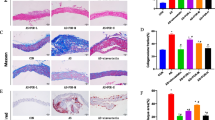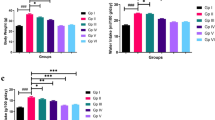Abstract
Objective
To investigate the effect of Qingre Quyu Granule (清热祛瘀颗粒, QRQYG) on stabilizing vulnerable plaques in apolipoprotein E (ApoE) deficient mice.
Methods
Seventy-two male ApoE deficient mice were given a high-fat diet from 6 weeks of age. At the 16th week, all the mice were randomized into 3 groups: the QRQYG group, the simvastatin group, and the control group. Sixteen weeks after administration of 0.9 g/kg QRQYG, 3 mg/kg simvastatin or 10 mg/kg sodium chloride per day to the respective groups, the animals were euthanized. The pathological morphologic changes in the vulnerable plaques were evaluated, the matrix metalloprotease-9 (MMP-9) expression was measured by immunohistofluorescence, the soluble intercellular adhesion molecule 1 (ICAM-1) was determined by ELISA, the nuclear factor kappaB (NF-κB) subunit p65 was measured by quantitative RT-PCR, and, finally, thrombospondin-1 (TSP-1) was determined by the immunohistochemical method.
Results
The plaque cross-sectional area in the brachiocephalic artery (23.7%, P<0.01), the lipid core of the plaque (43.1%±3.1%), and the number of buried fibrotic caps of the plaque were significantly decreased in the QRQYG group compared to the control group (both P<0.01); furthermore, the thickness of the fibrotic cap of the plaque increased and the intra-plaque hemorrhage of the plaque decreased. The serum soluble ICAM-1 (27.1±5.1 μg/mL), the protein expression of MMP-9 and TSP-1 and the p65 mRNA expression increased in the QRQYG group in comparison with the control group (P<0.05 or P<0.01).
Conclusion
QRQYG could stabilize the vulnerable plaque through inhibition of the inflammatory response.
Similar content being viewed by others
References
Stoll G, Bendszus M. Inflammation and atherosclerosis: novel insights into plaque formation and destabilization. Stroke 2006; 37:1923–1932.
Goyette J, Yan WX, Yamen E, Chung YM, Lim SY, Hsu K, et al. Pleiotropic roles of S100A12 in coronary atherosclerotic plaque formation and rupture. J Immunol 2009;183:593–603.
Gautier EL, Huby T, Witztum JL, Ouzilleau B, Miller ER, Saint-Charles F, et al. Macrophage apoptosis exerts divergent effects on atherogenesis as a function of lesion stage. Circulation 2009;119:1795–1804.
Cheng WL, Wang Y, Cai Z, Ke YN, Liu XF, Fan SY. Effect of Qingre Quyu Granule on the vulnerable atherosolerotic plaque of carotid artery in patients with stable coronary artery disease patients with stable coronary artery disease. Chin J Integr Tradit West Med (Chin). 2009;29:1085–1088.
Suzuki J, Iwai M, Mogi M, Oshita A, Yoshii T, Higaki J, et al. Eplerenone with valsartan effectively reduces atherosclerotic lesion by attenuation of oxidative stress and inflammation. Arterioscler Thromb Vasc Biol 2006; 26:917–921.
Rosenfeld ME, Polinsky P, Virmani R, Kauser K, Rubanyi G, Schwartz SM, et al. Advanced atherosclerotic lesions in the innominate artery of the ApoE knockout mouse. Arterioscler Thromb Vasc Biol 2000;20: 2587–2592.
Johnson JL, Jackson CL. Atherosclerotic plaque rupture in the apoli-poprotein E knockout mouse. Atherosclerosis 2001;154:399–406.
Calara F, Silvestre M, Casanada F, Yuan N, Napoli C, Palinski W. Spontaneous plaque rupture and secondary thrombosis in apolipoprotein E-deficient and LDL receptor-deficient mice. J Pathol 2001;195: 257–263.
Zhou J, Moller J, Danielsen CC, Bentzon J, Ravn HB, Austin RC, et al. Dietary supplementation with methionine and homocysteine promotes early atherosclerosis but not plaque rupture in apoE-deficient mice. Arterioscler Thromb Vasc Biol 2001;21:1470–1476.
Williams H, Johnson JL, Carson KG, Jackson CL. Characteristics of intact and ruptured atherosclerotic plaques in brachiocephalic arteries of apolipoprotein E knockout mice. Arterioscler Trterioscler Vasc Biol 2002;22:788–792.
Morrow DA. Cardiovascular risk prediction in patients with stable and unstable coronary heart disease. Circulation 2010;121:2681–2691.
Moreno PR, Sanz J, Fuster V. Promoting mechanisms of vascular health: circulating progenitor cells, angiogenesis, and reverse cholesterol transport. J Am Coll Cardiol 2009 23;53:2315–2323.
Barlic J, Zhu W, Murphy PM. Atherogenic lipids induce high-density lipoprotein uptake and cholesterol efflux in human macrophages by up-regulating transmembrane chemokine CXCL16 without engaging CXCL16-dependent cell adhesion. J Immunol 2009 15;182:7928–7936.
Wu H, Gower RM, Wang H, Perrard XY, Ma R, Bullard DC, et al. Functional role of CD11c+ monocytes in atherogenesis associated with hypercholesterolemia. Circulation 2009;119:2708–2717.
Robertson L, Grip L, Mattsson Hultén L, Hulthe J, Wiklund O. Release of protein as well as activity of MMP-9 from unstable atherosclerotic plaques during percutaneous coronary intervention. J Intern Med 2007; 262:659–667.
Bennett BJ, Scatena M, Kirk EA, Rattazzi M, Varon RM, Averill M, et al. Osteoprotegerin inactivation accelerates advanced atherosclerotic lesion progression and calcification in older ApoE-/-mice. Arterioscler Thromb Vasc Biol 2006;26:2117–2124.
Yearley JH, Xia D, Pearson CB, Carville A, Shannon RP, Mansfield KG. Interleukin-18 predicts atherosclerosis progression in SIV-infected and uninfected rhesus monkeys (Macaca mulatta) on a high-fat/high-cholesterol diet. Lab Invest 2009;89:657–667.
Wang Y, Zhao X, Jin H, Wei H, Li W, Bu D, et al. Role of hydrogen sulfide in the development of atherosclerotic lesions in apolipoprotein E knockout mice. Arterioscler Thromb Vasc Biol 2009;29:173–179.
Shaw JA, Bobik A, Murphy A, Kanellakis P, Blombery P, Mukhamedova N, et al. Infusion of reconstituted high-density lipoprotein leads to acute changes in human atherosclerotic plaque. Circ Res 2008;103:1084–1091.
She ZG, Zheng W, Wei YS, Chen HZ, Wang AB, Li HL, et al. Human paraoxonase gene cluster transgenic over expression represses atherogenesis and promotes atherosclerotic plaque stability in ApoE-null mice. Circ Res 2009;104:1160–1168.
Lawson C, Wolf S. ICAM-1 signaling in endothelial cells. Pharmacol Rep 2009;61:22–32.
Schmidt C, Hulthe J, Fagerberg. ICAM-1 and VCAM-1 are increased in initially healthy middle-aged men who develop cardiovascular disease during 6.6 years of follow-up. Angiology 2009;60:108–114.
Abilleira S, Bevan S, Markus HS. The role of genetic variants of matrix metalloproteinases in coronary and carotid atherosclerosis. J Med Genet 2006;43:897–901.
Lin SJ, Shyue SK, Hung YY, Chen YH, Ku HH, Chen JW, et al. Nuclear factor κB signaling in atherogenesis arteriosclerosis. Thrombosis Vascul Biol 2005;25:904–914.
Moura R, Tjwa M, Vandervoort P, Van Kerckhoven S, Holvoet P, Hoylaerts MF. Thrombospondin-1 deficiency accelerates atherosclerotic plaque maturation in ApoE-/-mice. Circ Res 2008;103:1181–1189.
Author information
Authors and Affiliations
Corresponding author
Additional information
Supported by the Capital Medical Development Scientific Research Foundation (No. SF-2007-III-41)
Rights and permissions
About this article
Cite this article
Wang, Y., Cheng, Wl., Ke, Yn. et al. Effect of Qingre Quyu Granule (清热祛瘀颗粒) on stabilizing plaques in the brachiocephalic artery of apolipoprotein E deficient mice. Chin. J. Integr. Med. 16, 442–447 (2010). https://doi.org/10.1007/s11655-010-0545-6
Received:
Published:
Issue Date:
DOI: https://doi.org/10.1007/s11655-010-0545-6




